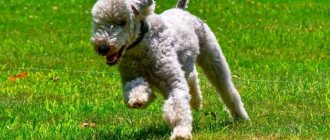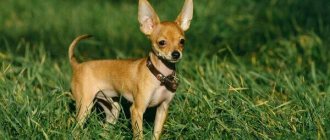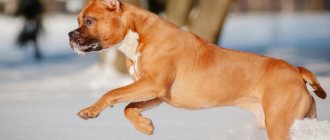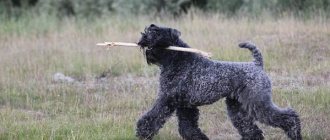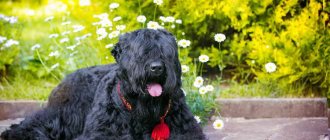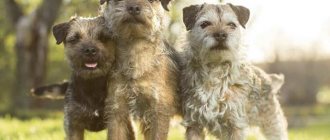History of the Bedlington Terrier breed
The first Bedlingtons appeared in the northern counties of England in the 18th century. At that time, the breed was known as the Rothbury Terrier, and its representatives were bred by gypsies and traveling circus troupes. The ancestors of today's Bedlingtons did not look very presentable, but they demonstrated amazing prey, providing gypsy families with rabbit stew all year round. Animals were also brought to work by English slaughterers. Dogs were lowered into the mine to deal with the hordes of rats and mice that lived inside and destroyed the meager meals of the workers.
In the 19th century, the British Esquires began to acquire Rothbury Terriers. Among the first to do this were William Allan and Edward Donkin, who lived in the vicinity of Northumberland and kept on their property many breeding individuals that were crossed with other breeds. As for the modern name, it came to terriers in 1825, when Northumberland dogs took part in a demonstration hunt in the vicinity of the city of Bedlington.
Since 1859, the breed has won dog shows, and the offspring of its representatives have been registered in the stud books of Northumberland County. Already in 1893, the Bedlingtons had their own national club, and four years later a separate standard was written for them. Further - more: the descendants of Rothbury Terriers went to conquer North America, where they were warmly received and even registered with the AKC. By the way, during the era of the “roaring 20s” in the USA, the breed lines of Colonel Guggenheim and William Rockefeller, who raised the first American champion Bedlingtons, became especially famous.
Bedlington Terrier breed standard
The modern Bedlington Terrier is a glamorous fashion model with indescribable plasticity of movements and noble grace of the silhouette. Having given up his profession in the last century, this charmer quickly transformed into a regular at exhibitions and an elegant companion with whom he would not be ashamed to appear at a social gathering. Wool plays an important role in the aristocratic image of Bedlingtons. Fluffy, forming stylish rings on its face, it resembles a bizarre mix of lamb and poodle “fur coats”.
Sexual dimorphism in the breed is pronounced. Bitches are shorter and generally more graceful than males. Males have a more textured appearance and toned figures, but at the same time retain their natural grace and slightly dry appearance. The height range of dogs at the withers is from 37 to 45 cm, weight varies from 8 to 10 kg.
A haircut with smooth transitions gives Bedlington Terriers a slight cosmic chic. Thanks to this technique, the dog’s head takes on a distinctly ovoid shape, reminiscent of the skull of an alien creature.
Head
The Bedlington Terrier has a narrow, rounded skull of good depth and without a pronounced stop. The top of the head is covered by a fluffy white cap. The line going to the nose from the back of the head is smooth, without bulges or depressions.
Nose
The lobe is black or brown, depending on the color of the coat. The nostrils are well defined and large in size.
Lips, jaws, teeth
The dog's lips fit tightly to the long, narrow jaws. The teeth are large and strong, closing into regular “scissors.”
Eyes
The brilliant small eyes of the Bedlington Terrier are set deep. A mandatory nuance is the angular cut of the eyelids, which makes the eyes look triangular. The color of the iris directly depends on the shade of the coat. Blue dogs have dark eyes, tan and blue dogs have brown-amber eyes, and liver and sand dogs have light hazel eyes.
Ears
The Bedlington's ear flap is medium in size, very thin, resembling the outline of a walnut leaf. The ears are set low and droop down along the cheekbones. The skin on the outside is covered with short velvety hair and has neat fringed tassels on the ear tips.
Neck
The low-set neck of the Bedlington Terrier has no chin, is of good length and widens in the shoulder area.
Frame
The dog's body is muscular, flexible, longer than the height of the animal at the withers. A distinctive feature of the silhouette is an arched back with a dome-shaped curve in the lumbar region. The Bedlington Terrier's chest is deep with flat ribs. The lower abdomen and groin line are well toned.
Limbs
The front legs are without curvature, but the distance between them at chest level is greater than at paw level. The shoulders of representatives of the breed are flattened and set obliquely; pasterns slightly sloping. The hind limbs of the Bedlington Terrier are more muscular and longer than the front ones. The hock joints are well defined, without eversion. Long hare feet with plump, tightly compressed toe pads look impressive. In a calm environment, the Bedlington Terrier moves with a springy mincing step, but if necessary, it can speed up and switch to a swaying gallop.
Tail
The Bedlington's tail is of normal length and curved. It is strong at the base, smoothly turning into a thin tip. A prerequisite is that the tail should not be held higher than the back.
Wool
The silky thick coat does not lie tightly to the skin, but does not puff up to the sides either. In addition, the hair can curl into rings, which is especially noticeable in the area of the muzzle and head.
Color
Standard colors: blue, tan, blue, liver and sand (with or without tan).
Disqualifying faults
Serious disadvantages of Bedlington Terriers are:
- cryptorchidism;
- non-standard color and coat structure;
- brown earlobes, lips and eyelids with blue or blue and tan fur;
- undershot or overshot;
- depigmented skin of the eyelids, nose, lips.
Behavioral deviations from the norm are also sufficient grounds for disqualification. If an animal behaves cowardly or aggressively, it will not be allowed into the ring.
Hunting
Today, Bedlington rarely participates in real hunting for foxes, badgers, rabbits and other animals living in burrows. But owners often organize a hunting game for their pets, called agility. At their core, such games are real sports and dogs fully realize their hunting skills during training.
In principle, a dog that has undergone agility training may well participate in a real hunt. This will even be useful for the dog, as it will allow him to actively spend time and spend all his accumulated energy. But at the same time, during simple walks, the Bedlington will have to be kept exclusively on a leash, since it can perceive any small animal as an object of hunting.
Character of the Bedlington Terrier
Beneath the Bedlington’s angelic appearance lies a classic “terrier” dog, periodically trying on the leader’s crown and terrorizing small fluffies depending on the mood. And yet, decades of exhibition breeding have not been in vain, so the breed, of course, has hunting instincts, but not in such a heightened state as, for example, in Jagdterriers. The Bedlington Terrier can be called a master of disguise. This stylish handsome guy transforms with equal success into both an intelligent, good-natured person and a cunning egoist who fiercely defends his own position.
Bedlingtons do not tend to show aggression towards humans, but sometimes the pet is able to give a test “bite” if the owner has crossed the boundaries of what is permitted and is planning an execution such as a routine vaccination or claw trimming. The Bedlington Terrier integrates into the society of other dogs without any problems, but this does not mean that he is ready to serve in a pack. On the contrary, this comrade will certainly respond to every provocation on the part of his fellow tribesmen, not forgetting to use his signature evasions and sudden bites in the “rear” in the fight.
At home, Bedlington is practically a good boy. He is moderately playful, not annoying and always in a great mood. The breed will also not turn the apartment upside down, although its representatives are distinguished by increased energy. But being jealous of the owner’s cats is a sacred thing for a Bedlington Terrier, so in the presence of a purring dog, it’s better not to be too affectionate. If there are children in the house, the dog is ready to accept this fact as a given, but only on the terms of polite neighborliness. If little naughty creatures regularly pester the animal, causing it discomfort, the Bedlington Terrier may fight back. Keep this in mind and try to limit communication between your pet and children if the latter see the four-legged creature as a living toy.
As for the famous terrier obstinacy, the Bedlingtons were not spared. Well, in order to get to know this character trait of a dog, it’s enough to shout at it well or infringe on its rights and established habits. The dog will respond to such “universal injustice” with moderate disobedience, or even with secretly planned revenge. Otherwise, the Bedlington Terrier is a moderately calm and friendly companion who loves joint outings and road trips. Yes, sometimes he is not averse to loosening the neighbor’s flowerbed and demonstrating the sharpness of his teeth on the furniture upholstery, but all this is more out of boredom and idleness than out of harm.
Breed characteristics and character
The Bedlington Terrier gives the false impression of an innocent “lamb.” It really looks like a sheep in the structure and color of its coat. However, this angelic body contains a real ferocious beast.
The breed was first recorded in the mid-18th century in the English town of Bedlington, where the name of the animals came from. By the way, if there is no fur, the dog will clearly resemble a hound. His movements are graceful and his body is quite flexible. In general, the dog resembles a cartoon heroine.
The original function of the dogs was to hunt small rodents that caused damage to granaries and inhabited mines. Subsequently, catching predators such as rats was added to this duty. In addition, the terrier was used as a gun dog.
And gypsies often taught dogs tricks, earning money by demonstrating the trained animal. In addition, the dog was trained to steal - he slyly snooped through pockets and brought booty to the camp in the form of wallets.
The first standard was developed in the second half of the century before last. From that moment on, dogs began to participate in exhibitions and competitions. After some time, the pet's appearance was modernized and improved. The dog handlers also made adjustments to the character.
The dog is very stubborn, but develops quickly, so it needs early socialization and physical activity. It can fight to the death, so when walking a pet, the owner must be on guard and nip dog squabbles and conflicts in the bud. Doesn't like life without chasing cats, and is fond of digging holes.
The terrier is not suitable for every owner. A beginner simply cannot cope with a grumpy dog. Moreover, the animal does not tolerate rudeness; an individual approach is required. He treats his household with love and devotion, but also tolerates loneliness calmly. Therefore, the owner, who has been away for a long time, will not find chewed shoes and broken dishes upon arrival.
Education and training
It is important to answer the question from the very beginning: for what purpose was the dog purchased? If this is a representative of the working lines with whom a full-fledged hunt is planned, then the educational process will have to be combined with elements of training. By the way, once you have awakened the hunting instincts in a Bedlington Terrier, you will not be able to pacify them, so either do not start hunting with the breed at all, or do it on an ongoing basis. As for domestic and show animals, of which the vast majority are in Russia, they can be trained according to the classic scenario: socialization - education - training. Owners of show pets will additionally have to learn the basics of handling (an exhibition demonstration of an animal), or entrust this task to a specialist who will teach the dog the ring stance and correct movements.
Home classes can be combined with trips to training grounds, but such lessons should not be mutually exclusive. Remember, the dog is obliged to follow commands in any situation, and not just when the figure of a professional trainer is looming over it. Walking is also best used to practice basic skills from the OKD course. True, before starting outdoor activities, your pet needs to be given the opportunity to run around and let off steam.
Otherwise, Bedlington Terriers are trained in the same way as the rest of the group, that is, they make it clear that dominance over the owner will not work. The command given by a person must certainly be executed. You need to start obedience lessons at two months of age, when the puppy is ready to learn the demands of “Come to me!” and “Place!” At four months you can introduce more complex commands “Near!” and “Sit!” By the way, about the last command: experts do not recommend introducing it into the skills of show dogs, since in the ring animals are exhibited exclusively in a standing position.
In the first year of life, Bedlington Terriers are the most active and ready to play pranks, so be prepared to hide wires, expensive shoes, and cover upholstered furniture. It is better to replace all these items with toys that the dog will bite, chew and scratch. If your pet makes a mistake, you should not yell at him. Bedlington Terriers agree to recognize their owner as the leader of the pack, but do not tolerate hysterical swearing. In order for the puppy to realize the mistake, a stern tone is enough. And of course, no retroactive punishments - animals are simply not able to understand their expediency.
Secrets of dog handlers that help in training
Many years of research by scientists in New York, commissioned by several large dog breeding clubs, have confirmed that success in training is not affected in any way by the weather (except for anomalies), but it is advisable to do it at approximately the same time of day.
The nervous system and intelligence of dogs depend on nutrition. A well-trained pet is a well-fed pet, not deficient in proteins, B vitamins, and has access to clean water. Veterinarians advise taking a bottle of water with a bowl for walks.
Dogs with a sociable personality who live in the same apartment are more likely to learn training in company. The instinct to imitate members of the pack is triggered. When a cat lives in the family and, of course, it does not understand commands, this cannot negatively affect the dog’s training.
Teams begin to study with generous rewards, praises and gradually reduce the number of treats, leaving the reward with words and touches. Or the animal will develop a consumer attitude towards humans.
There are contraindications for training:
- The dog is sick;
- The weather is hot, stuffy, the sun is scorching;
- The animal is afraid - of a thunderstorm, of an unfamiliar environment.
Dogs that have recently given birth are relatively weak in responding to fresh commands - mothers are completely absorbed in caring for their offspring for 1-2 months.
Having bought your pet a collar, leash, muzzle, demi-season, winter suit - they accustom it to things and later you can return to training.
When practicing diverse commands, they are mixed more often - getting used to working in a certain, memorized order, the dog does not truly assimilate them.
The best 5 most common kitten diseases
The basic team can be considered a miniature educational process. It is not enough to say “Sit” for the dog to learn it.
Analyzing training on the “Sit” command, it is easy to outline the sequence of actions of the owner:
- The dog is addressed with a command, without adding extraneous words;
- The owner’s palm gently presses on the animal’s withers, the second on its lower back, encouraging it to go down, the command is repeated a second time;
- Having seated the pet, the person removes his hands, steps back, pronounces the command a third time;
- The finishing touch is praise, the dog is called by name, and rewarded with a tasty treat.
During training, the condition of the animal is observed. Having noticed that the pet is constantly distracted by something, depressed or scared, the training is stopped. Perhaps the environment is not suitable for the dog or he is worried about his well-being. The lesson can be continued next time, but ignoring the signals given by the animal is unacceptable.
Training with an experienced instructor can be helpful. But it is impossible to entrust him with a dog for a short time, leave and return for the ideal pet. The psychology of a dog is such that it is determined to interact first with its owner and only then with the whole world. She is taught commands coming from him.
Train really tiny puppies, teenagers, adult animals. For the latter, it will take more time, effort, and patience, but a brilliant outcome has a chance of arising.
Dogs all over the planet need contact with their owner - purebred dogs, descendants of kennel champions, mongrels. Animal psychologists argue in academic works and lectures that it is not enough to give it to the animal only during feeding, walking, and training. At any hour when the owner is nearby, the pet should feel that he is needed. A well-mannered dog will not interfere with its human doing his business, but it will benefit from a couple of scratches behind the ear, an extra kind word, even a simple glance.
Maintenance and care
In the Russian climate, Bedlington Terriers are kept in apartments and houses. At the same time, it is permissible to walk a dog in any weather - after one and a half to two hours of walking in parks and squares, the animal will not freeze. If you want to maintain a presentable appearance for your ward, buy protective overalls for the off-season period. Despite the fact that Bedlingtons are tidy by birth, even they are not immune from dirty splashes flying from under car wheels. However, moderation must be observed here too. Prolonged wearing of waterproof clothes is fraught with the formation of woolen tangles on the dog’s body, which do not decorate it at all.
Hygiene and grooming
Bedlington Terriers have abundant hair not only on the body, but also in the ear funnel. In this regard, once a week the ear canal must be cleaned of secretions, simultaneously plucking out hairs that interfere with natural ventilation and accumulate sulfur secretions. The most convenient way to remove hair from the ear is plucking by hand or with tweezers. If the dog reacts too strongly to “epilation”, it is permissible to use scissors with rounded edges.
Once a month, the Bedlington Terrier should trim its nails with a clipper or any other nail clipper. If this is not done, the claw plate will bend inward, interfering with walking and distorting the position of the legs, which is especially harmful for show pets. For owners walking with animals on roads sprinkled with reagents, it is wiser to put their pets in special waterproof socks. Otherwise, after each such exit, the Bedlington will have to heal the cracked skin of the pads. As an alternative to walking socks, it is allowed to use protective waxes and balms for paws such as “Let's go for a walk!”, “Vedinol”. These products prevent the absorption of chemical compounds into the skin, protecting it from peeling and cracking.
The breed's teeth are healthy, so to prevent plaque and tartar, it is enough to give your pet a hard treat like dried beef ears, cartilage or dry fortified croquettes. Good results are obtained by lubricating the teeth with fresh tomato juice and brushing with zoopaste, but the dog is accustomed to such procedures from puppyhood.
Bedlington Terriers do not shed seasonally. The hair is gradually renewed throughout the year, so the main care for your pet is periodic combing of the body with a rubber mitten or brush to avoid the formation of tangles. Puppies under one year of age need to be brushed more often, as they shed more intensely. Junior wool changes to adult hair, and therefore falls off faster. In addition, starting from the age of three months, Bedlington Terriers are cut. If you do not plan to trust this procedure to a groomer, get hairdressing scissors, a clipper and a slicker brush. The last tool is useful for combing the dog's luscious hair before processing it with a clipper and scissors.
Most breeders prefer the classic version of the Bedlington haircut with smooth transitions and a fluffy cap on the head. However, there is also an American technique, when the dog is cut as short as possible, and the hair on the lower part of the tail, cheeks and throat is shaved. Bedlingtons cut this way look very unusual due to the translucent skin and narrow “cap” on the skull. As for patterns of dog “hairstyles,” they are easy to find on breed forums. However, you will have to use the templates at least four times a year - if you cut your animal less often, there is a risk of getting a hopelessly overgrown pet in unkempt tangles.
Bedlington Terriers need to be bathed every 2-3 weeks. In addition, after each walk you will have to wipe the animal’s paws and lower abdomen. To make the coat look shiny and comb better, it is necessary to use conditioners along with shampoo. More frequent bathing is carried out when the goal is to grow the coat faster - the use of softening masks and balms, as well as regular brushing, make the hair more pliable and stimulate blood circulation. It is also useful to buy talc or baby powder. Over time, the strands near the dog's mouth, under the eyes, tail and on the stomach acquire a brownish tint, which can be easily neutralized if the hair is treated with talc powder.
Important: throughout life, especially during pregnancy and nursing, the Bedlington Terrier’s coat changes color intensity, becoming darker and lighter. This is a normal and passing phenomenon that does not need to be dealt with.
Feeding
The natural menu of the Bedlington Terrier includes any lean meat, frozen fish fillets, low-fat fermented milk products, fruits and vegetables and cereals (rice). Vitamin complexes and dietary supplements, which are best selected on the recommendation of a veterinarian, will help make the diet optimally balanced. Breeders often recommend high-quality industrial feeds, starting from super-premium class and higher. True, to find your ideal one, you will have to spend some time.
An important nuance: many mineral components included in ready-made food color the coat of Bedlington Terriers, but it is unrealistic to predict in advance how the dog’s body will react to a particular brand.
It is unacceptable to feed your pet scraps from your own table. In addition, sweets, smoked foods, legumes and cabbage, raw carrots, nuts, chocolate, buckwheat, sweet fruits, as well as offal (liver, kidneys) are contraindicated for the breed. Tubular bones are also not given to Bedlingtons, nor are leafy greens.
Health and disease of Bedlington Terriers
The Bedlington Terrier is not the sickest breed, but it is prone to some health problems. Most often, its representatives suffer from eye diseases (glaucoma, retinal atrophy, distichiasis), protrusion, as well as hip dysplasia and ectopic ureters. Bedlingtons also have a unique genetic disease called copper toxicosis. The disease manifests itself at a young age and is caused by excessive accumulation of copper in the liver. In addition, if the pathology is not treated in a timely manner, the case will lead to intoxication of the body and death.
To prevent toxicosis, it is recommended to review your pet’s menu and exclude copper-rich foods, as well as industrial feeds in which the copper content exceeds 10 mg/kg. It is better to give distilled and deionized water to Bedlington Terriers with a tendency to get sick, and replace animal protein with easily digestible fermented milk (cottage cheese, kefir). In addition, for copper toxicosis, it is useful to introduce multivitamin complexes with vitamin K into the diet.
Diseases
The breed is prone to several serious diseases:
- copper toxicosis;
- distichiasis;
- retinal dysplasia.
All of them are related to the characteristics of the dog. Toxicosis occurs when a large amount of copper accumulates in the animal's body. In this case, the liver suffers the most. Disease can only be avoided if the dog’s diet is strictly controlled.
Distichiasis and dysplasia occur due to the special structure of the animal’s eyes. The owner should regularly take care of eye hygiene and, if symptoms of disease appear, immediately contact a specialist. A healthy Bedlington can live 12-14 years.
How to choose a puppy
- Be sure to get to know the litter's producers. Look at their pedigrees, as well as genetic copper toxicosis testing results, if available. Remember, individuals diagnosed with this disease are not officially allowed for breeding.
- Choose a “girl” if you are not confident in your teaching abilities - Bedlington Terrier bitches are more manageable and easier to train.
- Keep in mind that Bedlington Terrier puppies are born with a dark chocolate or black coat color that becomes lighter as the animal matures.
- If the titles of the baby's parents are important, go to dog shows, where you can meet the owners of champion Bedlingtons and negotiate the purchase of a puppy.
- When walking around shows and choosing breeding individuals from whom you would like to purchase offspring, pay attention to how many Bedlington Terriers are exhibited in the ring. It’s great if a manufacturer receives a title and an excellent rating through healthy competition. If one or a couple of contestants were exhibited at the event, there is a possibility that the judges overestimated the participants’ scores.
- Try to purchase Bedlingtons from single-breed nurseries or from breeders who specialize in only one breed - this way you are more likely to get a healthy animal that has received enough attention.
Bedlington Terrier price
In Russia, Bedlington Terriers are quite rare pets, which means that the search for a special breed kennel will have to be carried out not only within the country, but also in the former Soviet republics. As for the cost of puppies, you can purchase a club baby from European breeders from producers tested for copper toxicosis for 800-1100 euros. In nurseries of the CIS countries, prices are slightly lower - 400-700 euros (approximately 34,000 - 60,000 rubles), depending on the class of the puppy and the purity of its pedigree.
Price and where to buy a puppy
It is best to buy a dog from a professional breeder or kennel. In this case, you can be sure that the baby’s pedigree contains only purebred ancestors, and the puppy himself will be given all the relevant documents. A puppy bought secondhand may be too aggressive, since neither he nor his parents most likely received professional education and training. The cost of a terrier varies from 45 to 70 thousand rubles.
